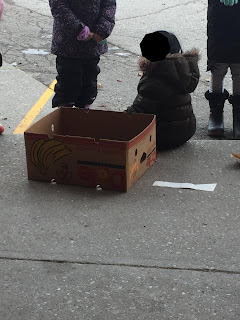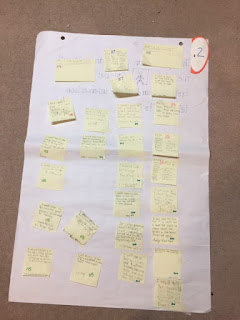This is a photo of a large group of students playing with boxes.
It inspired me to write about some of the simple things that bring children a lot of joy, especially the students I see at school regularly.
Boxes
I was the culprit that provided over a dozen boxes for the students to use outside at recess in (almost) whatever way they wanted. Usually, I save boxes for use in my STEAM program and dismantle them to create more storage space. However, one afternoon, I watched two students who were supposed to be working on a STEAM project with cardboard instead play very happily with intact boxes. They sat in them. They drew on them. They stacked them. I stopped them eventually, because when you only have 40 minutes of construction, it's not wise to waste that limited time. Their play planted a seed and when I received a large shipment of donated books in sturdy but dusty banana boxes, I decided to save them for outdoor play.
The great thing about these boxes was that they were free and when they got wet and wrecked, I had no qualms about putting them in the recycling bin. They also encouraged a lot of creative, cooperative play outside.
The not-so-great thing about these boxes was that some of the play got a bit rough at times and not every student was diligent about bringing the scraps of boxes in from the field after recess was over.
Sand
It's been a green Christmas and not a very snowy winter so far. Maybe that's why the kinetic sand I brought out for limited use in the library became so popular. Everyone - and I mean everyone - from junior kindergarten to Grade 8 loves using the sand.
The great thing about the sand was that it had no age-limits or prescribed gender-roles. Students once again played creatively and cooperatively. Students built sand castles and prepared sand ice cream. They squished and shaped structures to their heart's content.
If you followed my Twitter account, you know what the not-so-great thing is about sand in a carpeted library.
Maybe kinetic sand was not a good idea as a free exploration centre in the library #libraryfail pic.twitter.com/YqBHrNTyP1— Diana Maliszewski (@MzMollyTL) December 9, 2019
These are photos of three separate days after students *enthusiastically* used the sand. We talked about keeping the sand in the bins. We had student volunteers help me clean up. We had huge tarp-like garbage bags cover the floor for protection. Nothing worked for long. Some Grade 1s entered the library with blue pants and left with white pants; they were covered from ankle to waist in sand and I really can't explain how this was possible. The worst part was when my wonderful, patient caretaker walked in with one of his supervisors, who was not impressed. His supervisor had to "have a word" with me and I got an earful. Thankfully, both my caretakers (day and evening) and my principal are very forgiving and understanding human beings. The sand came out of the carpet very well with some focused vacuuming and hand-broom action (although I am technically banned from using the school vacuum because I was inadvertently, in my quest to save the caretakers from extra labour, doing their job that I was not supposed to conduct). The sand is now banished from my library forever. (Shhhh ... it now lives in JL's room - she'll use it on her [tiled] floors for STEAM inquiries.) I'll probably replace it with slime or thinking putty in 2020. (So much for learning my lesson!)
Sticks
My camera roll is full of photos of students building things with Keva Planks. Students love to build with these and love to have me capture what they built on film. This particular student was super-dedicated at recess and collected actual sticks to create a long railroad track. He is a train aficionado and this track-building brought him so much joy. I promised to save his efforts with several pictures. He knew that it probably wouldn't last after lunch recess but he persevered.
These observations make me even more inclined to populate my library with loose parts that inspire open-ended play (instead of toys that sometimes dictate how they are to be used). I suspect the Kindergarten AQ I'm scheduled to take from January to March will talk about how play fits into the kindergarten curriculum. I look forward to learning more with this course.
 As for me personally... what would my adult simple pleasures be?
As for me personally... what would my adult simple pleasures be?1) Sleep - During the holiday, I've scheduled quite a few naps.
2) Food - I highly recommend the "Eggs Benedict Cumberbatch" at Storm Crow Manor and the regular Eggs Benedict at Markham Station. There's something quite decadent for me about brunch at a restaurant. (The Eggstro at Over Easy is another personal favourite breakfast meal of mine.)
3) Conversation with Friends - although Debbie Donsky's post, https://debbiedonsky.com/konmaring-relationships/, was an insightful reflection about curating people in our lives. I'm looking forward to my New Year Eve's Eve gathering with some very old friends from university. If you are still on break, enjoy the respite.




































